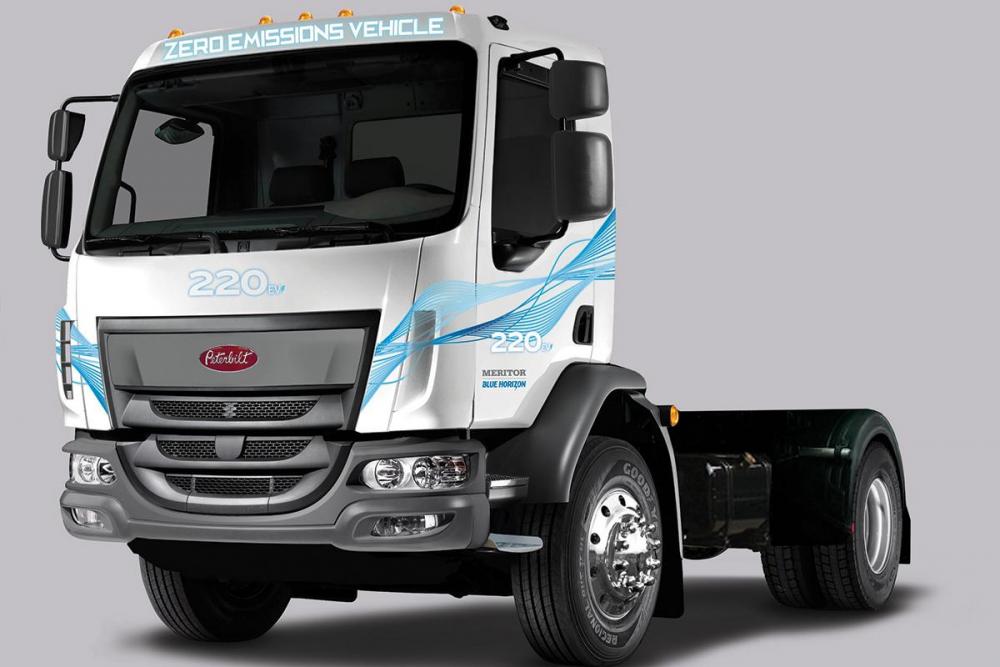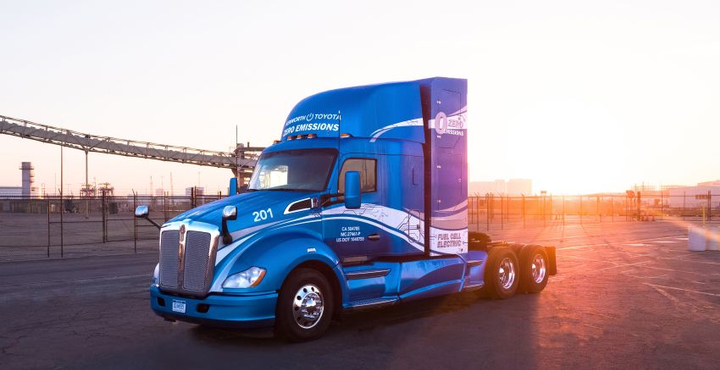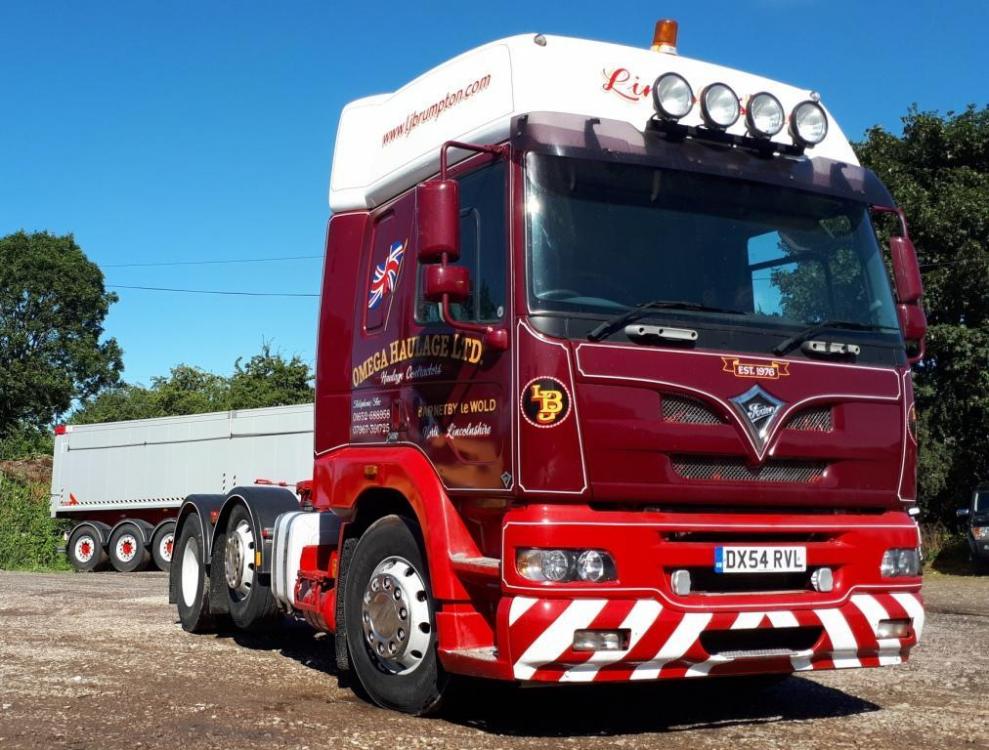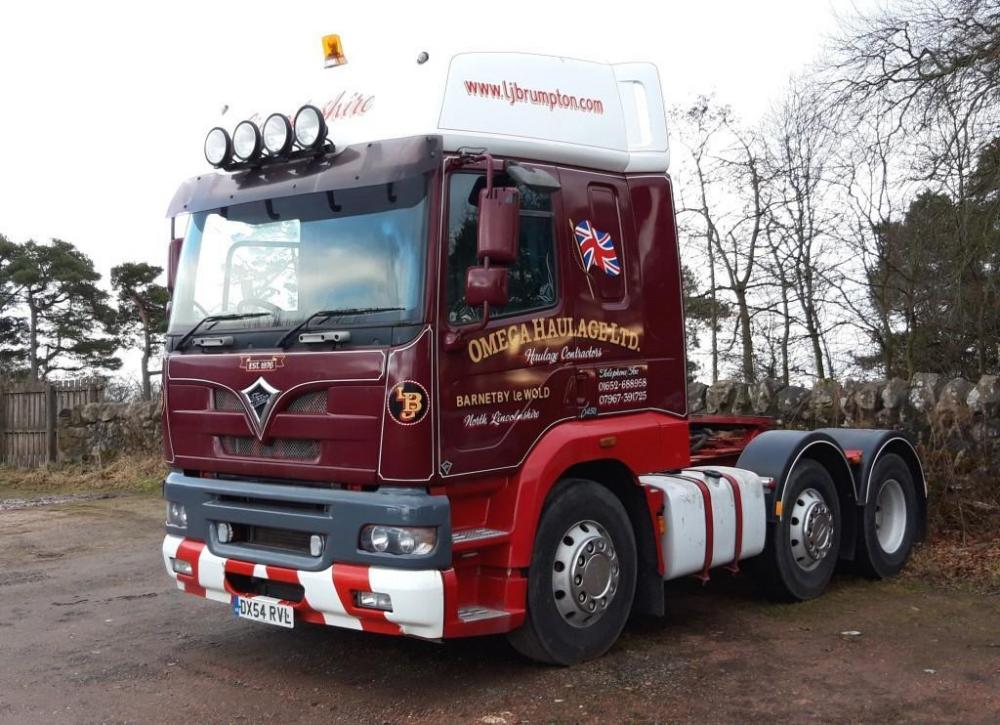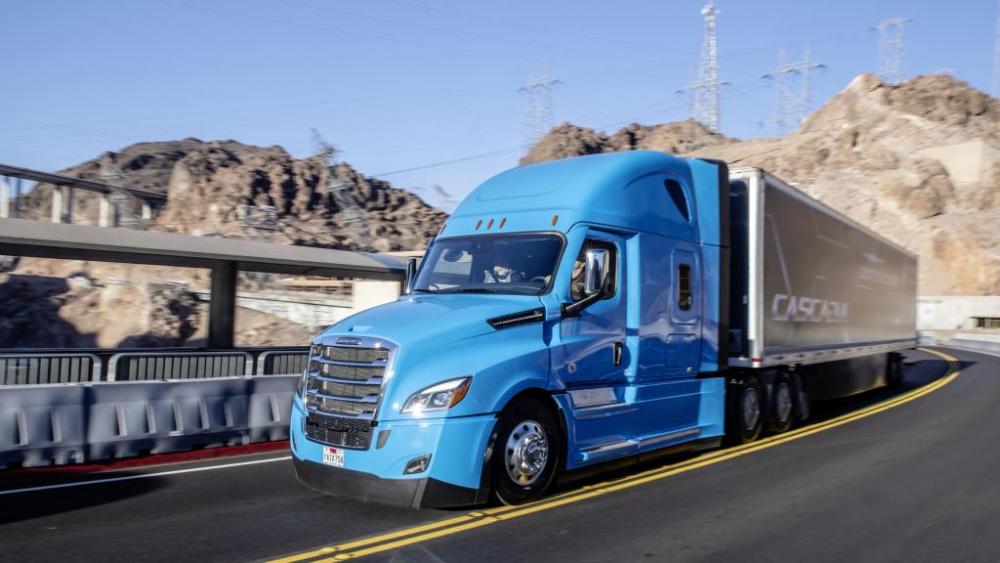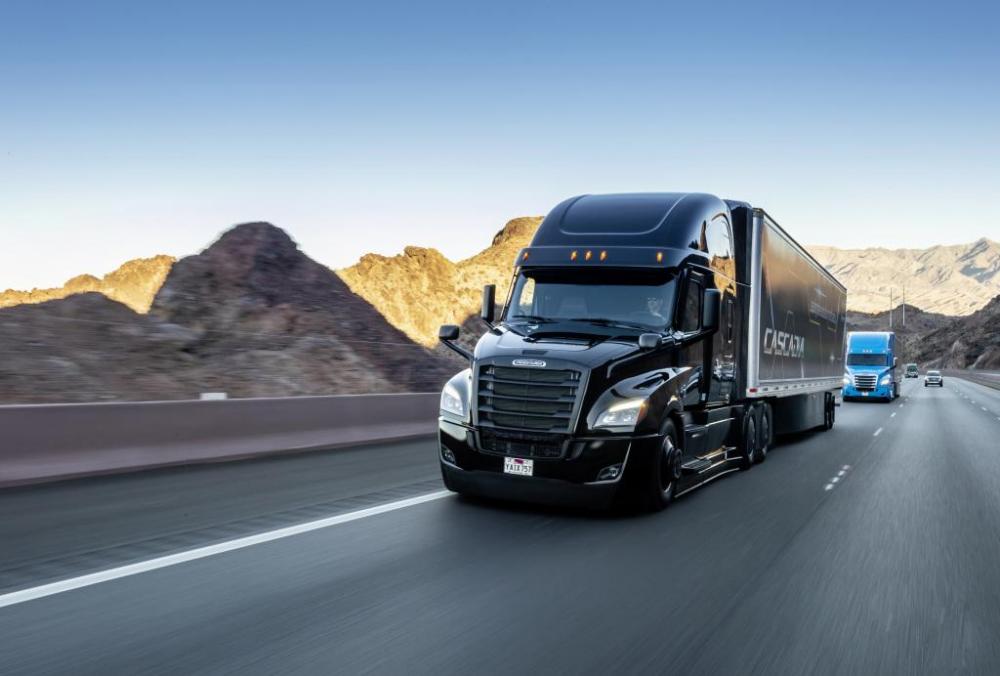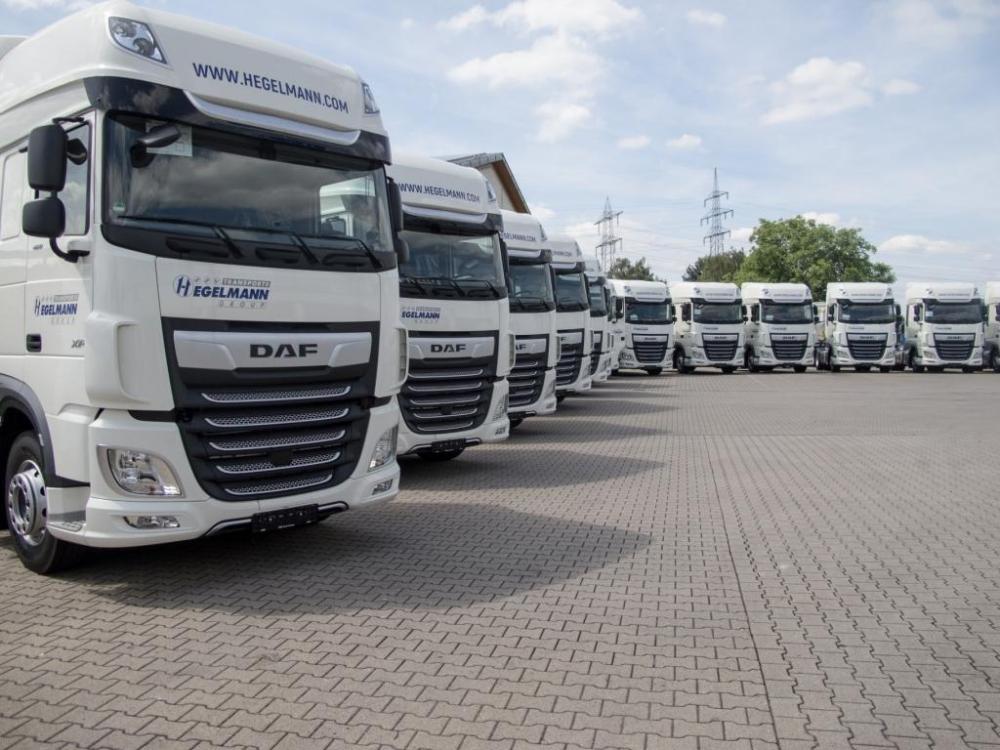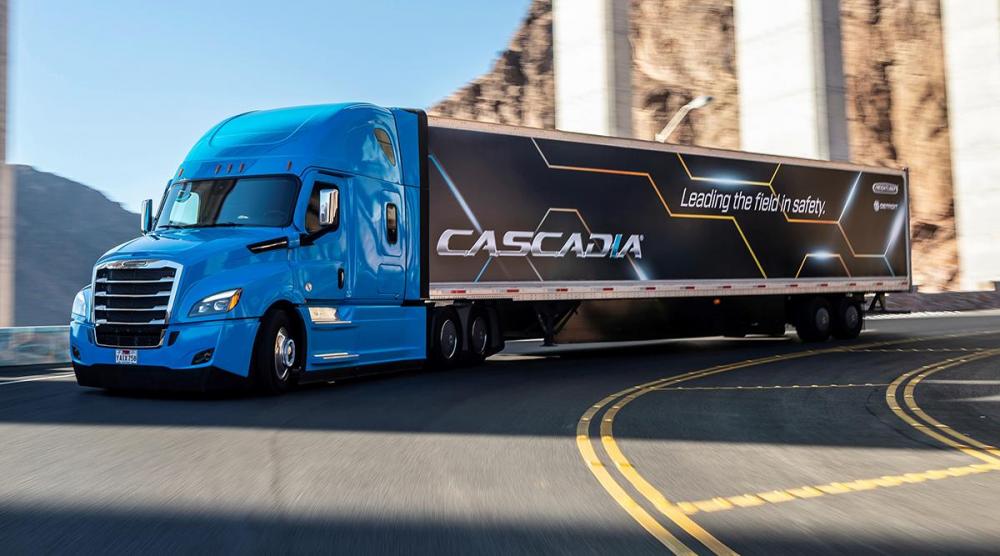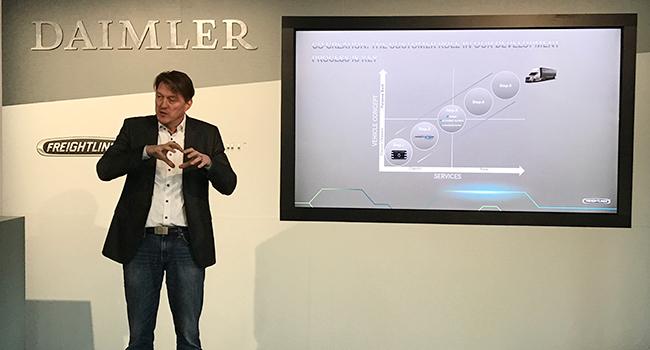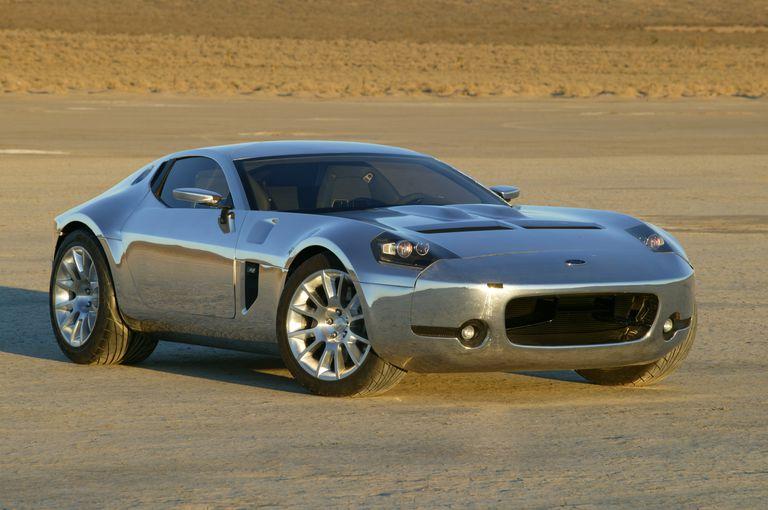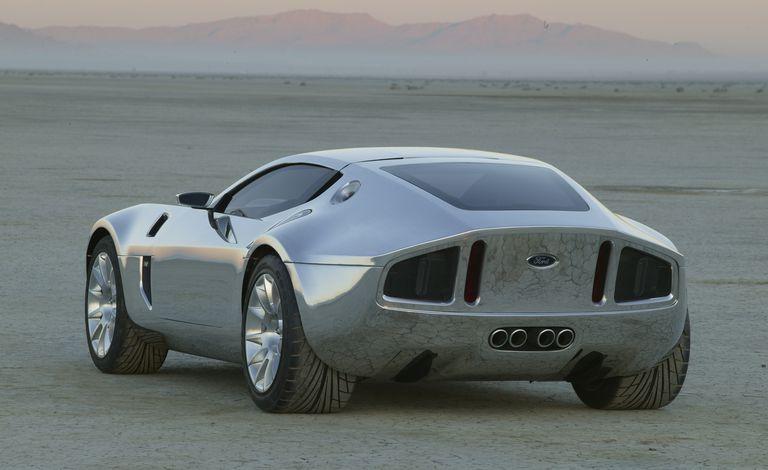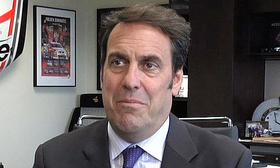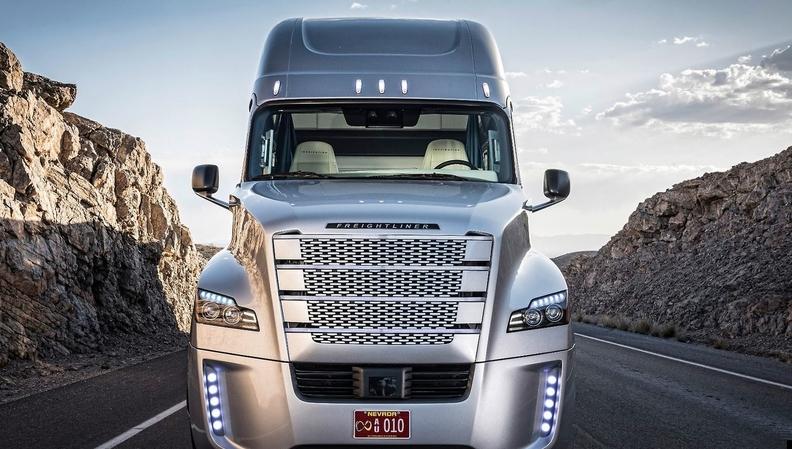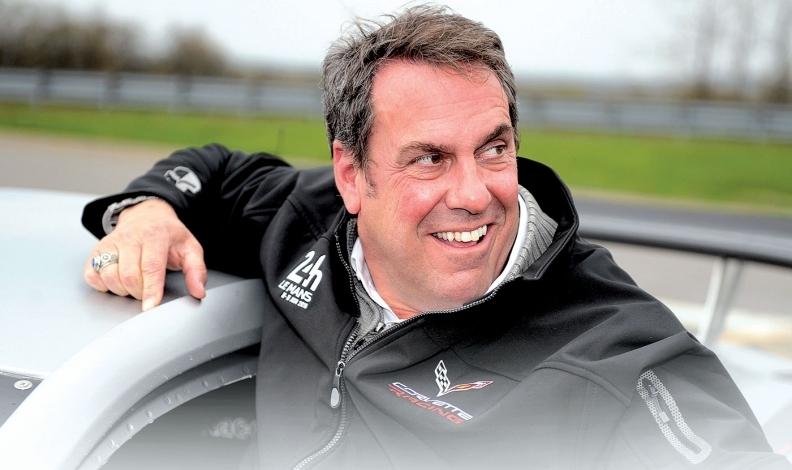
kscarbel2
Moderator-
Posts
18,918 -
Joined
-
Days Won
114
Content Type
Profiles
Forums
Gallery
Events
Blogs
BMT Wiki
Collections
Store
Everything posted by kscarbel2
-
Peterbilt Unveils Electric Medium-Duty Truck at CES
kscarbel2 replied to kscarbel2's topic in Trucking News
-
Seth Clevenger, Transport Topics / January 8, 2019 LAS VEGAS — Peterbilt Motors Co. has unveiled an all-electric medium-duty truck, adding a third model to its emerging electric-vehicle lineup. The truck maker introduced the zero-emissions Model 220EV on Jan. 8 here at CES, the world’s largest technology trade show. The battery-electric cabover, geared toward local pickup and delivery operations, has a 100-mile range and can recharge in an hour when plugged into a fast-charging system, the manufacturer said. Peterbilt said it plans to begin delivering the Model 220EV in the summer and will place six of the trucks into service this year with an undisclosed customer. The Model 220EV is equipped with two TransPower battery packs for a total storage capacity of 148 kilowatt hours and a Blue Horizon two-speed drive eAxle from Meritor Inc. The medium-duty model joins two other electric trucks introduced by Peterbilt within the past two years: the Model 579EV, a Class 8 tractor for port drayage and regional applications, and the Model 520EV, an electric refuse truck. Altogether, Peterbilt said it will have more than 30 electric vehicles on the road by the end of this year with customers in regional haul, refuse and urban delivery applications. “Peterbilt has been at the forefront of truck electrification, and adding the medium-duty platform to our electric truck lineup was a natural evolution of our development plan,” Peterbilt General Manager Jason Skoog said in a statement. “We will now have trucks in the three applications where electric powertrains may have a return on investment for our customers.” Peterbilt currently has Model 579EVs and 520EVs on the road in customer field trials. The truck maker also is conducting validation testing at the Paccar Technical Center in Mount Vernon, Wash. Peterbilt said it will use the data collected through its customer trials and testing to help ensure that its electric vehicles meet the same standards as its diesel trucks. .
-
Toyota Explores Heavy Truck Hydrogen Fuel Cell Application
kscarbel2 replied to kscarbel2's topic in Trucking News
Toyota, Kenworth Collaborate on Zero-Emission Trucks Heavy Duty Trucking (HDT) / January 8, 2019 Kenworth Truck Company and Toyota Motor North America are collaborating to develop 10 zero-emission Kenworth T680s powered by Toyota hydrogen fuel cell electric powertrains. This collaboration is part of a $41 million Zero and Near-Zero Emissions Freight Facilities (ZANZEFF) grant preliminarily awarded by the California Air Resources Board (CARB), with the Port of Los Angeles as the prime applicant. The grant monies are part of a larger $82 million program that will put fuel cell electric tractors, hydrogen fueling infrastructure, and zero emissions cargo handling equipment into operation in the ports and Los Angeles basin in 2020. The Kenworth T680s will transport cargo across the Los Angeles basin and to inland cities – such as Ontario and San Bernardino – while generating zero emissions, other than water vapor, thanks to their fully electric hydrogen fuel cell powertrain integrations co-developed by Kenworth and Toyota. The Kenworth T680s with the Toyota hydrogen fuel cell electric powertrains combine hydrogen gas and air to produce electricity. The electricity powers electric motors to move the trucks, while also charging the lithium-ion batteries to optimize performance as needed. Sophisticated power management systems will apportion the electrical power from the fuel cells to the motors, batteries, and other components, such as electrified power steering and brake air compressors. The hydrogen fuel cell electric powered Kenworth T680s will have a range of over 300 miles under normal drayage operating conditions. The program will also fund foundational hydrogen fuel infrastructure, including two new fueling stations that, subject to a final investment decision by Equilon Enterprises LLC (dba Shell Oil Products U.S.), will be developed through Shell Oil Products U.S., to support the operation of the fuel cell electric trucks in Southern California. . -
Truck & Driver / January 3, 2019 https://www.truckanddriver.co.uk/big-lorry-blog/happy-new-year-from-truck-driver-and-biglorryblog-introducing-our-foden-alpha/ .
-
- 1
-

-
Daimler Trucks North America Introduces First SAE Level 2 Automated Truck in North America with the Freightliner New Cascadia Daimler Press Release / January 7, 2019 LAS VEGAS, Nev. – Jan. 07, 2019 – Today, Daimler Trucks North America (DTNA) introduced the first SAE Level 2 automated truck in series production in North America with the latest enhancements to the Freightliner new Cascadia®. Level 2 automation means the truck is capable of both lateral (steering) and longitudinal (acceleration/deceleration) control, and is part of the revolutionary truck technologies featured by DTNA at the Las Vegas Motor Speedway during the 2019 Consumer Electronics Show (CES). According to NHTSA, ninety-four percent of crashes are attributable to human error. Automating acceleration, deceleration, and steering reduces the chance for human error, mitigates collisions, and can potentially save lives. These technologies can also enhance the driver experience by making the truck-driving task easier, thereby improving driver comfort and well-being. DTNA’s expertise in automation is backed by Daimler Trucks, which announced today at CES an investment of over half a billion dollars and an addition of more than 200 new jobs in its global push to put highly automated trucks (SAE Level 4) on the road within a decade. Most of these jobs will be located at the new Daimler Trucks Automated Truck Research & Development Center at DTNA’s headquarters in Portland, Ore. Automation for Safety, Driver Experience, and Efficiency In May 2015, DTNA pioneered automated driving with the introduction of the Freightliner Inspiration Truck, which was the first automated truck licensed to operate on U.S. public highways. Today, the new Cascadia delivers SAE Level 2 driving capabilities with the Detroit Assurance® 5.0 suite of camera- and radar-based safety systems. This new, proprietary system marks a key milestone in Freightliner’s relentless pursuit of industry-leading overall safety, driver experience, and fuel efficiency. The system can accelerate, decelerate, and steer independently. The Detroit Assurance 5.0 Adaptive Cruise Control and Active Lane Assist features make automated driving possible in all speed ranges for the first time in a series production truck: Adaptive Cruise Control to 0 mph: Improves safety, efficiency, and driver comfort by automatically decelerating and accelerating to maintain a safe following distance. This technology is especially important for maintaining a comfortable driving experience in congested traffic conditions where repeated braking, accelerating and resetting of traditional cruise control can lead to driver fatigue. Active Lane Assist: Consists of Lane Keep Assist and Lane Departure Protection. When Adaptive Cruise Control is enabled, Lane Keep Assist supports the driver by using micro-steering movements to keep the new Cascadia centered in its detected lane. With Lane Departure Protection, if the truck begins to drift without the turn signal engaged, the system will counter steer the truck back into its lane and give an auditory and visual warning. In addition to Level 2 automated driving features, the Detroit Assurance 5.0 active safety and advanced driver assistance systems are designed to keep truck drivers, pedestrians, cyclists, and other motorists safe: Active Brake Assist 5.0: The fusion of Detroit Assurance 5.0 camera and radar technology detects moving pedestrians and cyclists in front of the truck and can deploy full braking – an industry first. It can also detect and mitigate a collision with full braking on moving and stationary vehicles and objects. Side Guard Assist: Detects objects, including pedestrians and cyclists, in the passenger-side blind spot for the tractor and a full-length 53-foot trailer, another industry first, and delivers an audible and visual warning. “The enhancements we’ve made to Detroit Assurance have the potential to make an immediate, measurable and positive impact on overall North American road safety,” said Kelly Gedert, director of product marketing for Freightliner and Detroit. “In fact, fleets with trucks equipped with forward collision mitigation systems can experience a 60% to 80% reduction in rear-end crashes, resulting in potentially fewer accidents and reduced operational costs to our customers.” Detroit™ Connect Analytics will provide fleets with analysis and key insights on the performance of the new Detroit Assurance 5.0 safety features. Fleets will be notified if drivers have their hands off the wheel for longer than 60 seconds. Aerodynamic and Powertrain Efficiency Gains The new Cascadia also features one of the industry’s most efficient designs, inside and out. Thanks to DTNA’s significant investment in ongoing R&D in aerodynamics, powertrain development and systems intelligence, the new Cascadia delivers a 35% improvement in fuel efficiency compared to the first Cascadia introduced in 2007. This equates to annual savings of up to 4,700 gallons of fuel per truck, which is the amount of fuel consumed by six typical family cars in a year. Aerodynamic enhancements to the new Cascadia include Aerodynamic Height Control. An industry first, Aerodynamic Height Control electronically lowers the suspension height at 55 mph to optimize airflow over and under the front of the truck and reduce drag. Other enhancements include Michelin X Line D+ Energy tires developed in collaboration with Michelin, which reduce rolling resistance in 6x4 applications, and a low ground clearance bumper. Another critical component of the new Cascadia’s performance is its Integrated Detroit Powertrain, a powerful combination of a proprietary heavy-duty engine, transmission, and axle that is designed to seamlessly work together for maximum efficiency. The integrated powertrain features Intelligent Powertrain Management 6, which uses the truck’s kinetic energy to automatically adjust to the truck’s surroundings by reducing braking power and making transmission and engine adjustments, saving fuel and reducing wear and tear on components. “It’s not just the new Cascadia’s aerodynamic shape, specific options or powertrain components that make it the best – it’s that these features are engineered to seamlessly work together,” said Kary Schaefer, general manager, marketing and strategy for Daimler Trucks North America. “And we are the only truck manufacturer to offer that level of integration.” For fleets concerned with fuel economy, Detroit Connect Analytics will also introduce new Intelligent Powertrain Management reporting capabilities, and the fuel analysis will indicate if the vehicle is using Aerodynamic Height Control. “With more than 65,000 customer deliveries to date and 50,000 on order, the new Cascadia has proven to be the Class 8 truck of choice in the industry,” continued Schaefer. “We’re proud to be once again raising the bar.” .
-
Daimler Press Release / January 7, 2019 World premiere of the new Freightliner Cascadia with partially automated driving features (level 2) Start of series development of highly automated driving (level 4), enabling automated driving mode on specific routes without required user intervention Increasing safety, boosting transportation performance and significantly cutting costs per mile New R&D center for automated trucks fosters knowledge transfer for accelerated speed of innovation Martin Daum: “As a leader of our industry, we’ve been pioneering automated trucking. In 2015, our Freightliner Inspiration Truck got the first road license ever for an automated commercial vehicle. Now we take automated trucking to the next level: we’re ready to launch the first partially automated new Freightliner Cascadia in 2019 – and next, we tackle highly automated trucks. Highly automated trucks will improve safety, boost the performance of logistics and offer a great value proposition to our customers – and thus contribute considerably to a sustainable future of transportation.” Stuttgart / Las Vegas. Today at the Consumer Electronics Show (CES) in Las Vegas, Daimler Trucks announced that it will invest EUR 500 million (around 570 million USD) over the next years and create more than 200 new jobs in its global push to bring highly automated trucks (SAE level 4) to the road within a decade. Highly automated driving is characterized as automated travel in defined areas and between defined hubs without any expectation of the system that a user will respond to a request to intervene. In commercial trucking, level 4 is the natural next step after level 2, increasing efficiency and productivity for customers, cutting costs per mile significantly. In doing so, Daimler Trucks is skipping the intermediate step of conditionally automated driving (level 3). Level 3 automated driving does not offer truck customers a substantial advantage compared to the current situation as there are no corresponding benefits to compensate for the technology costs. The new Freightliner Cascadia offers partially automated driving features (level 2), making it the first-ever partially automated series production truck on North American roads. It also made its world premiere during today’s presentation of Daimler Trucks at CES. Daimler Trucks has been a pioneer of automated truck development for years. In 2014, the world’s leading truck manufacturer presented the Mercedes-Benz Future Truck 2025, the world’s first automated truck, and was the first to demonstrate the technological opportunities and great potential that automated trucks have for the economy and society. Martin Daum, Member of the Board of Management of Daimler AG with responsibility for Daimler Trucks & Buses: “As a leader of our industry, we’ve been pioneering automated trucking. In 2015, our Freightliner Inspiration Truck got the first road license ever for an automated commercial vehicle. Now we take automated trucking to the next level: we’re ready to launch the first partially automated new Freightliner Cascadia in 2019 – and next, we tackle highly automated trucks. Highly automated trucks will improve safety, boost the performance of logistics and offer a great value proposition to our customers – and thus contribute considerably to a sustainable future of transportation.” Level 2 automated driving now a reality in the new Freightliner Cascadia With Active Drive Assist (Mercedes-Benz Actros, FUSO Super Great) and Detroit Assurance 5.0 with Active Lane Assist (Freightliner new Cascadia), Daimler Trucks is already bringing partially automated driving features into series production. The new system can independently brake, accelerate and steer. Unlike systems that only work above a certain speed, Active Drive Assist / Detroit Assurance 5.0 make partially automated driving possible in all speed ranges for the driver for the first time in a series production truck. Active lateral control and the connection of longitudinal or lateral control in all speed ranges are new thanks to the fusion of radar and camera information. Daimler Trucks reassessing the benefits of platooning Moving forward with its innovation roadmap, Daimler Trucks is reassessing its view on platooning. Daimler Trucks defines platooning as the electronic coupling of two or more trucks with significantly reduced distance between them to, in theory, improve aerodynamics and therefore save fuel. Daimler Trucks has tested platooning for several years, especially in the U.S., where benefits would be expected to be the most substantial. Results show that fuel savings, even in perfect platooning conditions, are less than expected and that those savings are further diminished when the platoon gets disconnected and the trucks must accelerate to reconnect. At least for U.S. long-distance applications, analysis currently shows no business case for customers driving platoons with new, highly aerodynamic trucks. Daimler Trucks will, of course, remain committed to all partner projects that are still ongoing. Level 4 automated driving improves safety, efficiency and competitiveness Highly automated trucks (level 4) offer enormous advantages in many areas. In today’s society, there is a growing desire for safer roads and more sustainable transport solutions – and level 4 trucks can considerably contribute to that. They enhance safety in traffic thanks to a redundancy of systems and a multitude of sensors and systems that never get tired or lose attention – because today, a great majority of accidents are still due to human error. Level 4 highly automated trucks also improve efficiency and productivity, among other things, through higher utilization of the vehicles – practically around the clock. They also make it possible to travel during light traffic times, for example at night, and thus avoid traffic jams by intelligent route management. This has positive effects for truck customers and for the entire economy: the competitiveness of an economy is strongly correlated with the efficiency of logistics. This aspect becomes more and more relevant as global road freight volume is expected to more than double between 2015 and 2050. 200 new jobs for engineers or robotics specialists with IT and programming skills Daimler Trucks is creating 200 new jobs in the area of highly automated driving (level 4). The newly created positions and roles are to be filled primarily by mechatronics engineers or robotics specialists with IT and programming skills. The main location is Daimler Trucks & Buses new Automated Truck Research & Development Center in Portland (Oregon, U.S.). The center’s experts are dedicated to all aspects of developing, testing and validating automated vehicles. In addition, the engineers in Portland work in close cooperation with their colleagues in the research and development centers at Daimler Trucks locations in Stuttgart (Germany) and Bangalore (India), thus forming a global network. Interested talents can apply at https://daimler-trucksnorthamerica.com/lead/ or directly to innovateDTNA@daimler.com. Requirements for highly automated driving of cars and trucks differ considerably A crucial success factor for the development of a safe and reliable level 4 highly automated truck is a closely coordinated system of engineering and technology development. Daimler Trucks uses the extensive knowledge from many years of experience in developing driver assistance systems. And the transfer of knowledge within the Daimler Group forms the basis of a high speed of innovation. Thanks to its overall portfolio ranging from passenger cars and vans all the way to buses and trucks, the Daimler Group is ideally positioned for all relevant application scenarios of automated driving. Scalable solutions are therefore available. Across all divisions, the company is guided by a clear philosophy which is based on introducing a safe, dependable and mature system. Developments from the Mercedes-Benz Cars division suitable for haulers and their transport needs will also be used at Daimler Trucks. Level 2 systems now available will be raised to level 4 through innovation and the re-definition of existing systems. Despite all the similarities, the requirements for highly automated driving of cars and trucks differ considerably from one another. The sheer size of a truck makes higher demands on the technology than in the passenger car sector as do moving systems on an articulated system, for example. In addition, the driving behavior due to a greater mass or other deceleration values as well as other driving characteristics, for example in curves, place much higher demands on the system. The operating conditions in the transport industry are also much tougher. In order to enable efficient delivery cycles and to meet customer requirements for fast delivery, the vehicles must be operated for as long as possible. This must not lead to any restrictions in durability or reliability, for example under a wide variety of weather conditions and extreme vibrations. Finally, public acceptance is a key factor to successfully integrating level 4 systems into the value chain. Two sensors are currently in use at level 2. In the next development step at level 4, there will be significantly more, all also higher performing. This leads to a completely new level of data volume but also places extremely high demands on the quality of data processing. The goal: the driver's perception is recreated by the holistic recording of the traffic and vehicle situation by different sensor technologies. With their specific strengths, each sensor makes a contribution to the overall performance and safety. Three different technological approaches form the basis: radar, camera and lidar. The safety, precision and durability of the systems will already play a leading role at launch. As in aircraft, all safety-relevant functions will therefore be equipped with a redundant system that is capable of seamlessly taking over in case the primary control system malfunctions. . .
-
DAF Trucks Press Release / January 2, 2019 Renowned international transport company, Hegelmann Transporte Group, is expanding its fleet with 540 DAFs XF 480 Super Space Cab. The tractor units will be supplied to the south German company on a programmed delivery throughout 2019 and 2020. It is the third large order in quick succession for DAF Trucks, following orders for 400 trucks from waste-to-product company Renewi and 1,500 units from fleet operator Girteka Logistics. Hegelmann Transporte was established in 1998 and has specialised in just-in-time transport for the car, heavy and food industry. Hegelmann’s 4,000 employees, 2,000 trucks and 2,000 trailers operate from the Algarve to the Chinese border. The company’s headquarters are located in Karlsdorf-Neuthard, near Stuttgart. Maximum uptime, highest ROI "To make our international growth strategy a success, we require maximum uptime and the highest possible return per kilometre,” states Siegfried Hegelmann, one of the two owners of the family business. “DAF understands that like no other. Our profitability is their goal – that makes DAF our ideal partner." Drivers put DAF on a pedestal Hegelmann already owns more than 100 trucks from the latest generation XF. Drivers praise cab comfort and space in the Super Space Cab, alongside excellent driving characteristics inherent to DAF's top-of-the-range model. "Because there is a large shortage of professional drivers, this also plays an important role in our choice to once again opt for the DAF XF," says Siegfried Hegelmann. Unrivaled fuel efficiency The newly ordered trucks are equipped with Predictive Cruise Control (PCC), Lane Departure Warning System (LDWS), Advanced Emergency Braking System (AEBS) and Adaptive Cruise Control (ACC), ensuring both comfort and safety at the highest level. The exceptionally smooth 355kW / 483 hp PACCAR MX-13 engine delivers unmatched fuel efficiency. No less than 1,100 service points For the maintenance of its trucks - the XF has service intervals of up to 200,000 kilometers - Hegelmann relies on the dense DAF dealer network of more than 1,100 dealers and service points in Europe. In addition, the company has selected DAF MultiSupport for repair and maintenance contracts, ensuring timely preventive maintenance and optimum vehicle availability. .
-
Volvo Trucks North America (VTNA) / December 19, 2018 A lift axle solution for 6x2 tractor configurations, Volvo’s Adaptive Loading is designed to help trucks run at peak fuel efficiency and performance every mile of every haul. It senses weight differentiation and automatically lifts the axle to reduce friction and save fuel. Adaptive Loading also improves traction during lighter hauls, by transferring all weight to the rear axle of the vehicle. From a full load down to an empty trailer, this integrated and automated technology makes every driver a more efficient driver. .
-
Roger Gilroy, Transport Topics / January 7, 2019 LAS VEGAS — Daimler Trucks North America announced it would begin production in 2021 of medium- and heavy-duty battery electric trucks that are now being developed in close cooperation with select North American customers. DTNA is North America’s leading truck maker in Class 6-8 diesel-powered trucks, which face more stringent emissions for lowering truck emissions of carbon dioxide and other greenhouse gases in 2021, 2024 and 2027. In addition, in November, the U.S. Environmental Protection Agency announced it would issue a rule to further cut the emission of nitrogen oxide from diesel-powered heavy-duty trucks. DTNA’s efforts to develop battery-electric trucks is occurring against that backdrop. “This is not something we do here at Daimler Trucks North America ourselves. We are heavily involved in trying with all of these other development projects that we have at Daimler — in Japan and in Europe,” Andreas Juretzka, DTNA’s eMobility product lead, told the media at a ride-and-drive event here Jan. 6-7. DTNA is bringing customers in “at a very early stage” and will share that within the global development process, he said. Two fleets, Penske Truck Leasing and NFI Industries, will receive the first electric trucks. Penske will receive 10 eCascadias and 10 eM2s for use in California and the Pacific Northwest, while 10 eCascadias will go to NFI for drayage activities from the ports of Los Angeles and Long Beach to warehouses in California’s Inland Empire. At the event here preceding the annual Consumer Electronics Show, DTNA let reporters, for the first time, drive prototypes of its medium-duty eM2 and Class 8 eCascadia model. Behind the wheel of the eCascadia, it is hard to tell just by ear if the truck is running. There is no shifting through gears as it accelerates smoothly and silently — it has two e-axles and electric motors at the wheel hubs. As the truck, pulling a fully loaded trailer, takes the turns and heads down the straightaway, there is the expected agility and power, but engine noise is missing. In the cab, driving is peaceful. The eM2 offered a similar sense of a brand new experience for commercial vehicle drivers. Meanwhile, questions about the trucks’ operational cost, environmental benefits, their range, the needed infrastructure, their reliability and what lies further in the future are under serious discussion, according to DTNA. For example, leasing the truck batteries to fleets is being considered, Juretzka said. DTNA has an electric vehicle customer council that includes 30 key fleet customers. Its next meeting is scheduled for May. .
-
Superformance Will Resurrect Ford's Stunning Shelby GR-1 Concept Steve Siler, Car & Driver / January 7, 2019 Remember the Shelby GR-1 show car from way back in the early 2000s? That stillborn project is about to come back to life thanks to Superformance, a tuner based in Irvine, California. The company bills itself as "a distributor of complete, rolling-chassis replica and continuation race cars of the 1960s." But Superformance appears to have hit fast forward on that tape to, well, at least the middle of the past decade: CEO Lance Stander has announced that the company will add replicas of Ford's stunning 2004–2005 Shelby GR-1 show car to its product lineup. It's worth nothing (if you couldn't tell by looking) that the GR-1 was created in homage to the Cobra Daytona coupe. Currently, all of Superformance's products are indeed rooted in the 1960s and currently include replica or continuation Shelby Cobra, Ford GT40, Shelby Cobra Daytona, Caterham, and Corvette Grand Sport models. The announcement was made at the Petersen Automotive Museum's annual Shelby tribute on January 6 by Stander, who was part of a panel sharing stories about Shelby and discussing Shelby's influence on the industry and racing culture. With Shelby American vice president Vince Laviolette next to him on the panel, Stander said that Superformance has teamed up with Shelby American to develop electric versions of the gorgeous GR-1 in addition to a gasoline-powered version. Laviolette confirmed this but didn't provide any details other than to say, "It's gonna be very fast." Stander was more forthcoming, saying, "We're shooting for a two-second Shelby." "It's been a project I've been working on with Ford for about six years," said Stander. "We originally said we want to do the GR-1, and we spoke to everyone at Ford and they said it's never going to happen. Just forget about it. We could have done a replica, we could have done a kit car, but that was never good enough for us. We had to get licensed by the original manufacturer, and it had to have all credibility. So I just kept plodding along and eventually the stars aligned, the right people at Ford got to hear about it and . . . a couple of guys at who really wanted to see it happen at Ford Design in Europe, and the next thing I know is Ford Licensing is contacting me." The car won't be out for about two years, they said, but when it is, 200 aluminum special-edition GR-1 cars will be made available—which could be either polished or painted—with the remainder wearing carbon-fiber bodies. Whether Superformance will be able to call it by the concept's original name, Ford Shelby GR-1, or whether it will get a moniker such as Shelby Legendary GR-1 or just Shelby GR-1, is still an open question. And as for the idea of an electric GR-1? "Carroll [Shelby] was always on the edge," said Laviolette, who said Shelby was looking at electric powertrains before he died in 2012. "He was an innovator. And that's the way we still hold the company. You know, the world's changing, and we have to go with the world." .
-
Reuss consolidates power over product Michael Wayland, Automotive News / January 7, 2019 DETROIT — Mark Reuss now has his father's old job. His assignment is to make sure it won't be his father's General Motors. Reuss' appointment as president of GM last week caps a year of executive realignments designed to position the company for a wrenching restructuring that calls for not only staff and capacity cuts, but wholesale changes in how GM does business, from headquarters to r&d labs to the factory floor. Aside from the title change, the 55-year-old Reuss will assume responsibility for GM's quality organization from CEO Mary Barra. The promotion gives Reuss complete oversight of the vehicle side of the business. And it signals the urgency with which GM is pursuing its mission to prepare for potentially transformative change in the auto business. Reuss, a 35-year GM veteran whose father, Lloyd Reuss, was president from 1990 to 1992, described the appointment as "truly a great honor." He succeeds Dan Ammann, 46, who on Jan. 1 became CEO of GM's Cruise autonomous vehicle unit in San Francisco. "Mark has played a critical role in leading the development of the company's award-winning vehicles while transitioning his team to prepare for growing electrification and autonomous technologies," Barra said in a statement last week. Reuss' responsibilities as president will be more product-focused than Ammann's were. Barra will retain direct responsibility over regional operations across the globe and GM Financial, while CFO Dhivya Suryadevara will continue to oversee corporate development — previously all responsibilities of Ammann. 20 new vehicles Reuss had already taken over responsibility for Cadillac and global portfolio planning from Ammann in June 2018 and quickly began restructuring the product side of the house — a vast network with 32,000 employees that includes r&d, engineering, design, safety, quality and product planning — to focus more resources on autonomous and electrified vehicles. That transformation will continue, if not accelerate, as GM plans to launch at least 20 new battery-electric and fuel cell vehicles globally by 2023. Reuss has said GM is doubling the resources allocated to electric and autonomous vehicle programs in the next two years. The reorganization has been mirrored across the company with many top lieutenants of Barra and Reuss refocusing on autonomous and electrified vehicles. The efforts are meant to fulfill GM's "triple zero" vision of a future with zero crashes, zero emissions and zero congestion. One of the most high-profile moves was the appointment of Pam Fletcher, vice president of global EV programs, to the new position of vice president of global innovation and r&d laboratories in October. For more than a decade, Fletcher has been in leadership roles supporting the engineering of GM's EV and self-driving technologies. In her new role, in which she reports to Barra and Reuss, she is leading the teams at GM "whose mission is to disrupt the traditional automotive industry," according to her GM profile. That includes directing seven r&d labs around the globe that are focused on technologies such as battery chemistry, mixed-materials science, smart manufacturing systems and vehicle-to-infrastructure communications. More shuffling Other moves included Doug Parks' role as vice president of autonomous and EV programs expanding to include Fletcher's EV responsibilities; Michael Ableson, GM vice president of global strategy, moving to the new position of vice president, EV infrastructure; and changed assignments for several other vice presidents in the Global Product Group. The last major overhaul of GM's product development operations, led by Barra and Reuss, came nearly five years ago, as GM responded to the ignition switch crisis that was linked to 124 deaths and was facing stricter oversight from federal safety regulators at NHTSA. At that time, Reuss said the new structure would have "a militaristic zeal for preventing and resolving" issues like the defective ignition switch before they occurred. That commitment hasn't changed with Reuss taking over quality from Barra, said spokesman Mike Albano. Quality and safety remain "paramount, and that will never change no matter the organizational structure." .
-
Christoph Rauwald, Bloomberg / January 7, 2019 Daimler AG will start sales of a U.S. truck able to brake, accelerate and steer at all speeds on its own this year, a stepping stone to more automation as growing Internet shopping strains freight companies battling driver shortages. The updated Freightliner Cascadia, also with lane-keeping assistance, will fuse information from radar and cameras to enable partially autonomous technology, Daimler said Monday at the Consumer Electronics Show in Las Vegas. To maintain its lead over the likes of Volvo AB and Paccar Inc., the manufacturer said it plans to offer highly-automated vehicles, which don’t need drivers on some routes, within a decade. Highly-automated trucks will improve safety and boost the performance of logistics, Daimler truck chief Martin Daum said in a statement. Success in North America is vital for Daimler’s commercial vehicles unit to expand sales and profits after global deliveries rose above 500,000 vehicles last year, the highest in a decade. Daimler’s truck unit for years has struggled to lift returns beyond those of some smaller peers with fewer economies of scale and is now contending with rising investments in self-driving and electric trucks as well as digital services. Demand in the region is expected to moderate somewhat during the second half of this year, Roger Nielsen, the division’s North America head told reporters in Las Vegas. The world’s biggest commercial vehicle maker still expects “another great year” as orders remain strong, he said. The North American market is to reach a peak in 2019 after climbing to the highest level since 2006, according to Bloomberg Intelligence estimates. The Mercedes-Benz maker is currently working through its biggest corporate overhaul in a decade to give individual units more independence. Investors have called for a partial listing of the commercial vehicles division. Daimler is investing 500 million euros ($575 million) over the next few years in autonomous technology and is adding 200 jobs for the project, mainly in the U.S. Separately, the company said it doesn’t see a business case for so-called platooning, where two or more trucks are digitally coupled behind one another at a short distance to save fuel. Adding to competition from Volvo’s Mack brand and Paccar Inc., electric-car leader Tesla said it plans to start delivering heavy-duty electric trucks this year. .
-
The Navistar dealers are excited about the CV product. Designed and built by Navistar in partnership with GM, the CV/Silverado is a truck to be reckoned with. I suspect the GM commercial dealers will exceed our expectations.
-
T-Line sells Diamond T parts.....same cab as you have. Why don't you ask them? https://tlinetrucks.com/
-
Another company developing fuel-efficient, opposed-piston engine
kscarbel2 replied to BMT Forum Bot's topic in Trucking News
Achates Names New President and CEO Heavy Duty Trucking (HDT) / January 3, 2018 Achates Power has appointed David Crompton as president and CEO, joining the company after 28 years with Cummins where he served as president of both the engine business and power systems business. Crompton has experience in the powertrain industry covering pick-up trucks, commercial vehicles, military and off-road industries. He replaces David Johnson in the role who will remain an adviser to Achates. The appointment comes at a critical time for Achates Power, as the company plans to implement an opposed-piston engine and the company and investors have committed additional funding to speed up the design’s implementation into the marketplace. "Achates Power can make a positive impact on the future of transportation and industrial power by providing a superior option to deliver high efficiency and low emissions across current and future markets,” said John Wall, chairman of the board for Achates Power. “The Board and Investors have full confidence in the work that the Achates Power team is doing and the ability for Dave Crompton to help bring to market an ultra-clean, ultra-efficient, low-cost internal combustion engine." In 2018, Achates demonstrated a 2.7-liter Light-Duty Demonstration Vehicle and continued to develop its opposed piston gasoline compression ignition engine, and received funding from the California Air Resources Board (CARB) for a heavy-duty opposed engine demonstration program. -
It is. They have developed their own variant of a globally established engineering concept. The key note for Americans to realize is, the Chinese are now self-developing high-end technology of all sorts. Typical of Asians, they are aggressive (go getters).
-
Jason Cannon, Commercial Carrier Journal (CCJ) / January 4, 2019 North American Class 8 orders limped out of 2018, posting just 21,000 units – the lowest total since August 2017. However, it’s hard to look back unfavorably on last year considering heavy orders for the past 12 months totaled a staggering 482,000 units, according to FTR. Another analayst, who pegged Class 8 order totals for 2018 at 490,100 units, notes last year crushed the previous high-water mark of 390,000 units in 2004. “It is important to put slowing orders into context,” he said. “With a 300,000-plus unit backlog and a solidly booked build schedule, the drop in orders is in-line with expectations.” The December slide in order activity was expected as fleets ordered mostly to secure a shrinking number of available build slots during the second half of 2019. Don Ake, FTR vice president of commercial vehicles, says there are few build slots remaining this year and he expect orders totals to remain low the next several months. “Order rates right now are not that relevant because of the record-breaking totals recorded in June and July last year,” he says, adding backlogs will continue to fall but will remain lofty at the beginning of 2019. “Fleets got a jump on ordering to reserve 2019 build slots, so orders had to fall off at some point, and December was the start of it.” With orders rates reduced, Ake says they are not a good barometer of long-term demand. “All the orders are in, the question now is how many of these orders will actually be built,” he asks. “We will have to watch the build rates and retail sales closely for clues about the future strength of the Class 8 market. FTR forecasts freight growth to ease back some from the 2018 peak, but the expectation is that it will remain vibrant for the first half of 2019. “At some point, the economy and freight growth will moderate and truck builds will decline,” Ake says. “Then order cancellation rates will rise.”
-
China is getting closer to equipping its warships with electromagnetic railguns, state media reports -- which means its fleet could soon boast some of the most advanced weapons technology on the planet. Citing CCTV, the state-run Global Times on Thursday reported the underlying railgun technology -- which utilizes electrical power rather than explosives to launch projectiles -- was based on "fully independent intellectual property," rather than copied from other countries. Unconfirmed sightings of a Chinese landing ship apparently equipped with a test railgun in an undisclosed location have circulated around the internet this week. Carl Schuster, former director of operations at the US Pacific Command's Joint Intelligence Center, said it was significant that China appeared to be transitioning from copying foreign weapon designs to "developing their own" technology. "It also tells you (that China) is no longer 10-15 years behind (the US)... They are now approaching parity with the west in terms of weapons development," he added.
-
Ford Trucks International / January 3, 2019 http://fmax.fordtrucks.com.tr/en . .
-
Ford to run DAKAR 2019 with two 4x4 Cargo trucks
kscarbel2 replied to kscarbel2's topic in Trucking News
-
U.S. lifts tariffs on China-made injection molds Steve Toloken, Automotive News / January 4, 2019 WASHINGTON -- The Trump administration unexpectedly put a hold on steep 25 percent tariffs on injection molds imported from China in late December, a decision analysts say is likely to hurt American mold building companies but help U.S. plastics companies that supply automakers. The announcement from the U.S. Trade Representative (USTR) means that the 25 percent tariffs on injection molds -- imposed in July as part of the first round of $34 billion in duties on Chinese imports -- will be suspended for at least one year. USTR did not explain its decision, but one attorney for the mold making industry said it may be a response to a flood of more than 200 requests from plastic injection molding companies, many in the automotive supply chain, to exempt their specific mold imports [from Red China]. The USTR announcement is broader than molds, exempting about 30 different categories of imports from the tariffs. Molds are the largest plastics-related category. "I believe they have had so many requests from companies seeking exemptions of molds from the tariff, that the government decided to exclude molds in their entirety rather than spending resources on each individual exemption request for a mold," said H. Alan Rothenbuecher, a lawyer for the Indianapolis-based American Mold Builders Association. "No one knows for sure why, but that is my opinion." Rothenbuecher, a partner with the Cleveland-based law firm Benesch, Friedlander, Coplan & Aronoff LLP, said the ruling will hurt U.S. mold builders but help U.S. plastics companies that buy molds. "There was and is strong support among the [U.S.] mold builder community for these tariffs," Rothenbuecher wrote in an email. Plastics processors, however, said [whined] the higher costs from the 25 percent tariffs would be hard for them to absorb, causing significant problems in their already price-sensitive businesses [can't have your cake and eat it too]. Auto suppliers impacted Many argued to USTR that since mold purchasing takes months and the contracts for these molds were signed before the tariff details were discussed, they could not plan for the 25 percent tariffs. Plastikon Industries Inc., for example, asked for what it called a "one-time exclusion" for molds ordered from China in late 2017 for a project for a U.S. automaker. "Due to the timing, significant size and technical requirements for the U.S. vehicle launch, however, the company cannot re-source the items of concern to a U.S. supplier," the company said. It said [whined] a 25 percent tariff would "impart significant economic hardship," possibly forcing it to cancel the multiyear contract with the automaker and risking the jobs of 600 workers at one of its plants in Kentucky. Other companies, including plastics housewares maker Keter U.S. Inc., made similar points, arguing that higher tooling costs would make its U.S. manufacturing less competitive and risk jobs. Plastikon said it had taken steps to source more molds in the United States. "We fully support the strategic objectives of shifting manufacturing to the U.S. and have already taken steps to source future molds from the U.S. and from fair trade countries," Plastikon told the USTR. Automotive reaction More than half of the requests for tariff exemptions came from injection molding companies in the automotive supply chain and argued that the tariffs would raise costs or slow down vehicle development. [Chinese-owned] Yanfeng U.S. Automotive Interior Systems LLC, for example, submitted more than 80 requests. Forteq North America Inc. submitted more than 20, and International Automotive Components Group North America Inc. and Faurecia U.S. Holdings each requested more than 10 mold tariff exemptions. IAC -- which was founded by Trump's Commerce Secretary Wilbur Ross -- noted that its Chinese mold supplier is chosen directly by its customer, Ford Motor Co. IAC added that the U.S. mold making industry did not have capacity to meet its needs. The Center for Automotive Research in Ann Arbor, Mich., said lifting the tariffs will help hold down U.S. car prices but hurt mold makers who supply the industry. "It's good for autos; it's bad for domestic mold builders," said Kristin Dziczek, CAR's vice president of industry, labor and economics. "The mold industry in the U.S. is no better, no worse off than they were, but the protection from Chinese molds would have been beneficial." While the automotive injection molding sector was vocal in complaining that tariffs would bite them, the U.S. mold making industry has clearly faced its own worsening trade picture in recent years. The U.S. trade deficit in molds shot up from $1.14 billion in 2015 to $1.53 billion in 2017, the last full year figures are available, according to a recent report from the Washington-based Plastics Industry Association, which said the U.S. imports 3.5 times as many molds as it exports. The mold trade deficit with China rose from $390 million to $498 million in those three years. But industry trade data also suggests Canada may be the bigger challenger to the U.S. industry's trade picture. U.S. mold makers consistently have their largest trade deficits with Canada. It reached $884 million in 2017, and that rose from $690 million in 2015, according to the association's report. AMBA Executive Director Troy Nix said survey data collected from processors is now showing a trend toward more sourcing of molds in the United States. Nix added that the industry will be watching to see if eliminating tariffs on Chinese molds would slow or reverse that. Rothenbuecher said getting rid of the tariffs on Chinese molds will "plain and simple" hurt U.S. mold builders, but he also said the U.S. government may have been concerned about signs of overcapacity in the American mold making sector. Reaching capacity "It has been reported that the U.S. mold building industry may be or is at overcapacity with the amount of work that has been directed back to United States mold builders," Rothenbuecher said. "That consideration may have played into why molds are now being exempted from the tariff." Several U.S. injection molding companies argued that lead times are being stretched out for U.S.-built molds because the industry is at capacity. Mack Molding Co., for example, said in its filing that it goes overseas when U.S. capacity is tight: "Due to the more recent robust economy, many of the domestic mold shops have had a workload that prohibits us from getting fast deliveries on tooling to support our customers, so we have the tooling built in China and fly the molds back to the U.S." As well, custom injection molder Sajar Plastics told USTR it faces long lead times for tooling in the U.S. and is currently having 28 molds built in China. "U.S. tool shops typically take 18-20 weeks for each tool build," Sajar wrote. "Many of the tools we currently have in China are ready to ship within the next four weeks and be in production in the next 10 weeks." USTR said that the tariff exclusions would be retroactive to the original July 6 tariff announcement and would run until Dec. 28, 2019, one year past the official publication of the exclusions in the Federal Register. What happens after that is not clear, but some industry observers said they could be extended.
-
Mack Anthem Veteran Truck
kscarbel2 replied to Jarhead Enterprises's topic in Modern Mack Truck General Discussion
If you're pulling heavy loads, per Eaton, an overdrive version of their boxes is stronger than a direct drive unit. For US fleets pulling a mere 36k (or less), direct drive works. However, in the rest of the world where the norm is far more, an overdrive box is preferable. -
Reuss succeeds Ammann as GM president Michael Wayland, Automotive News / January 3, 2019 DETROIT -- General Motors product chief Mark Reuss will succeed Dan Ammann as president, the automaker said Thursday. Reuss, 55, will assume responsibility for GM's quality organization in addition to leading its Global Product Group and Cadillac. The appointment is effective immediately, according to GM. In November, GM said Ammann, 46, would step down from the role to lead the company's Cruise autonomous vehicle unit, effective Jan. 1. A replacement was not named. Reuss, whose father, Lloyd Reuss, served as GM’s president from 1990-1992, described the appointment as “truly a great honor.” The position’s responsibilities will be more product-focused for Reuss than they were for Ammann. GM CEO Mary Barra will retain direct responsibility over global regions and GM Financial, while GM CFO Dhivya Suryadevara will continue to oversee corporate development -- previously all responsibilities of Ammann. Reuss added responsibilities for Cadillac and global portfolio planning from Ammann in June 2018. Since then, he has been restructuring and building an integrated product development team that will focus significantly more resources on autonomous and electrified vehicles -- particularly battery-electrics -- while streamlining GM's army of engineers. Barra, 56, said Reuss’ appointment to president will continue to “strengthen” the automaker’s core business and “take advantage of growth opportunities and further define the future of personal mobility.” “Mark has played a critical role in leading the development of the company’s award-winning vehicles while transitioning his team to prepare for growing electrification and autonomous technologies,” she said in a statement. Reuss, a mechanical engineer and road racer, began his GM career as a student intern in 1983. The 35-year GM veteran has risen through the ranks to be one of the most well-known executives in the company -- particularly for his contributions to GM’s product portfolio and performance chops. Previously, Reuss was executive vice president, Global Product Development, Purchasing and Supply Chain from 2013-2018. Before then, starting in 2009, Reuss was president of GM North America, responsible for the automaker’s performance, manufacturing, portfolio and dealer network. He also created and led the GM Performance Division in 2001 while serving as executive director of Architecture Engineering. Reuss will continue to serve on the board of GM China’s joint venture, Shanghai General Motors Co. He also serves on several non-GM boards such as The Henry Ford and other Detroit-area philanthropic, business and educational organizations. .
BigMackTrucks.com
BigMackTrucks.com is a support forum for antique, classic and modern Mack Trucks! The forum is owned and maintained by Watt's Truck Center, Inc. an independent, full service Mack dealer. The forums are not affiliated with Mack Trucks, Inc.
Our Vendors and Advertisers
Thank you for your support!


